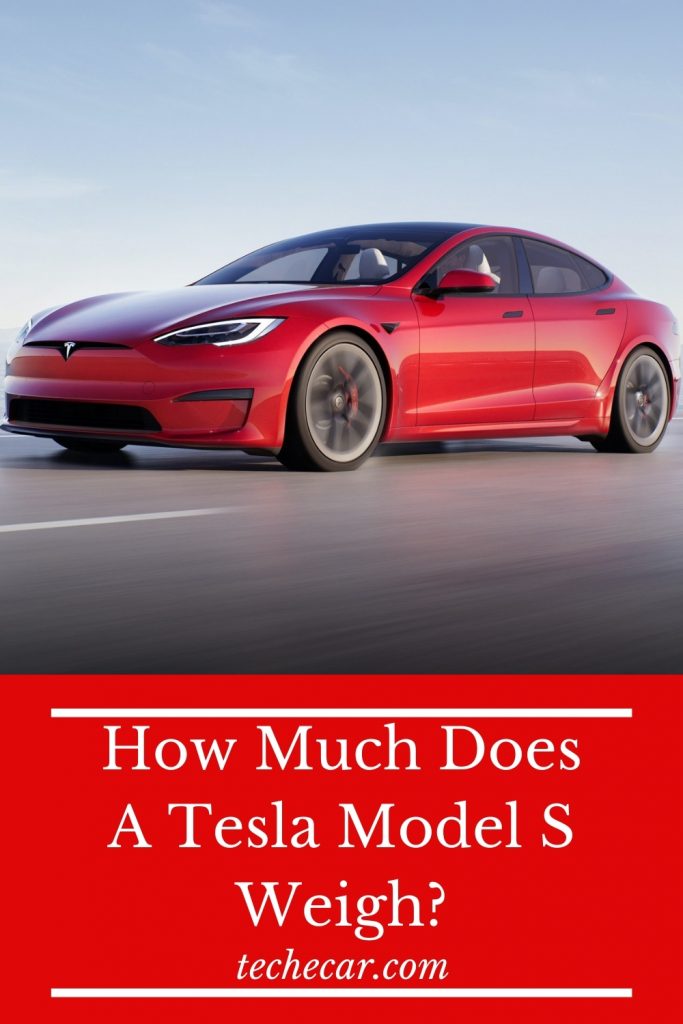How Much Does A Tesla Model S Weigh?


Topic: How Much Does A Tesla Model S Weigh?
Although they joined the auto market a few years ago, Tesla established their name. They have changed the rules of the game in the automotive market by making cars that are electric and environmentally friendly. By drastically reducing the weight of their cars, Tesla cars are the most efficient.
How much does a Tesla weigh? (Model S, Model 3 and Model X) The Tesla Model S weighs approximately 2,107 kg (4,647 lb). while the 3 and X models weigh 3,552 pounds (1,611 kg) and 5,421 pounds (2,458 kg) respectively. The Model S has a weight distribution of 48% and 52% for the front and rear. The Model 3 has a weight distribution of 47% in the front and 53% in the rear, and the Model X 49% in the front and 51% in the rear.
You can imagine charging your car like your phone. It sounds fascinating, but Tesla made it possible. Electric cars use electric power instead of diesel or gasoline. But again, one thing that scares me the most is whether these cars are efficient given the power required to move a car of such weight. Tesla electric cars are very efficient.
The Model S has a lightweight aluminum construction and is reinforced with high-strength steel for strength. The lightweight aluminum reduces the car’s overall weight, giving it excellent acceleration to 100 km / h in just over two seconds. Tesla revealed how they reduced the Model P100D by around 1,100 pounds (500 kg).
They have partnered with natural fiber composites manufacturer Bcomp to help reduce the bulk inside this car. They used bio-composite panels that are light but very rigid—using these lightweight materials resulted in a 20% weight reduction, which makes a significant difference to the car’s overall performance.
Using aluminum alloy wheels also saves weight. In addition to facilitating better acceleration, alloy wheels are suitable for use in areas with milder temperatures—less weight results in reduced rotational mass with better and faster braking. Aluminum alloy wheels are made of different materials that make them less flexible. Other features like the glass roof and frameless safety glass also contribute to weight reduction.
Tesla S has a massive battery that weighs 544 kg. The Tesla S also comes with two different battery configurations, which may give you different results in its weight difference of 4,647 to 4,940 pounds (2,108 to 2,241 kg).
How Weight Affects Car Speed
The acceleration of a car is affected by its full weight. We expect a light car to accelerate faster. A heavy car needs more power to accelerate. The recommended way to reduce the weight of a car is to replace some components with lightweight materials. Additionally, shedding excess weight can also improve speed without the need for any changes.
Weight distribution
Although ignored, weight distribution also affects speed, handling, braking, and cornering ability. Most people insist on a 50/50 weight distribution due to the sense of balance. However, it is not the weight distribution that gives the feeling but the air in the suspension. Having more weight in the rear provides greater stopping power. It naturally engages all the tires when braking. More front weight is only common on cars with a front lean.
More weight at the rear also means faster acceleration. It also drives faster than forwarding bias cars. They even have a tendency to oversteer, which is essential when cornering. All three Tesla cars (Models S, X, and 3) have more rear weight.
In short, Tesla cars are lighter. The Model S weighs approximately 4,647 pounds. The Model X averages 5,421 pounds. And the Model X tips the scales at about 3,552 pounds. Weight differences are due to the type of materials used, including batteries and other construction materials: the weight and weight distribution of a car influence braking, handling, and acceleration.
Recommended Article:
How Many Solar Panels To Charge An Electric Car?
How To Fix Electric Car Window?






[…] How Much Does A Tesla Model S Weigh? […]
[…] editorial team acquired and lived with a 2017 Tesla Model 3 Extended Range for almost two decades, logging 24,000 miles per hour. As a new design for Tesla, […]
[…] hand, electric vehicles can only give us a better range of about 316 miles on a single charge (Tesla Model Y). So should you recharge every […]
[…] Tesla Model 3 […]
[…] men were killed in a Tesla Model S. There was no one behind the wheel at the time of the […]
[…] assortment of 239 miles. That is not as much as opponents like the Chevrolet Bolt or even Tesla Model 3 are capable of, but it is still a lot for many EV […]
[…] options for the Tesla Model Y […]
[…] from 0 to 60 mph in just 4.3 seconds. That’s impressively quick but somewhat behind Tesla’s claim for its Model 3 Performance’s acceleration.Stopping from 60 mph took just 102 feet. That’s among the […]
[…] fast chargers can be found in many places. Some Honda, Nissan, Mitsubishi, Kia, and Tesla models are among the cars they charge. While 50 kW has been the current top power output, plans call for […]
[…] this amount of pre-orders pales compared to the Tesla Model 3, which saw many thousands of orders more quickly than the actual vehicle could reach 60 miles per […]
[…] competes with the Polestar 2 and the Tesla Model 3 . The eDrive40 variant includes a rear-mounted electric motor that produces 335 horsepower. […]